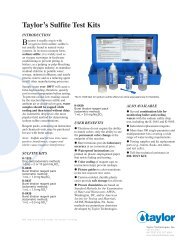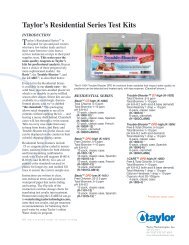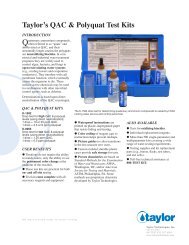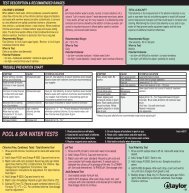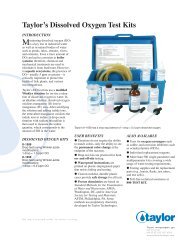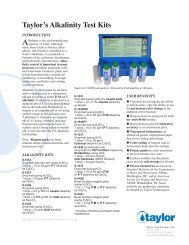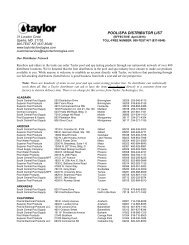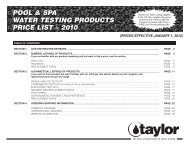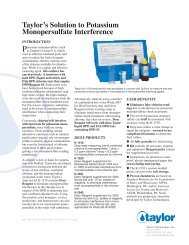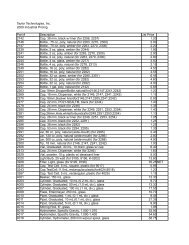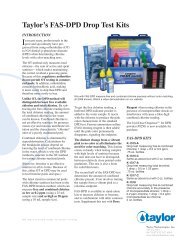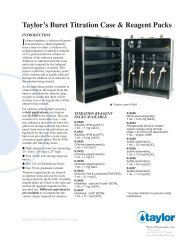Taylor's Test Kits for Food & Beverage Processors
Taylor's Test Kits for Food & Beverage Processors
Taylor's Test Kits for Food & Beverage Processors
You also want an ePaper? Increase the reach of your titles
YUMPU automatically turns print PDFs into web optimized ePapers that Google loves.
Taylor’s <strong>Test</strong> <strong>Kits</strong> <strong>for</strong> <strong>Food</strong> & <strong>Beverage</strong> <strong>Processors</strong><br />
INTRODUCTION<br />
What do fresh-cut vegetable and<br />
fruit processors, food, meat,<br />
and poultry processors, bakeries and<br />
pizza dough makers, canneries, sugar<br />
refiners, dairy plants, beverage bottlers,<br />
breweries, and even pet food manufacturers<br />
have in common? The need to<br />
analyze water quality at various points<br />
of the production cycle, often as part<br />
of their Hazard Analysis and Critical<br />
Control Point (HACCP) Program.<br />
Indeed, water is arguably the most<br />
important production “tool” in any<br />
food-processing facility. Taylor testing<br />
supplies are commonly used to monitor<br />
process water in tanks and flumes,<br />
rinse water following equipment/foodsurface<br />
sanitation, hand dip stations,<br />
water in boilers and cooling systems,<br />
and wastewater prior to discharge.<br />
If you are in a food or beverage<br />
business, or you supply watertreatment<br />
or sanitizing chemicals to<br />
this industry, or you per<strong>for</strong>m regulatory<br />
inspections at these operations,<br />
Taylor manufactures simple drop-count<br />
titrations and color-matching tests <strong>for</strong><br />
over 35 analytes to meet your watertesting<br />
needs.<br />
Other products that may be of interest<br />
to you include standard solutions,<br />
such as pH buffers and conductivity<br />
solutions <strong>for</strong> meter calibrations;<br />
general-use reagents such as acid<br />
starch indicator powder, sulfuric acid,<br />
and phenolphthalein indicator; and<br />
labware, including a resin-filled<br />
demineralizer bottle <strong>for</strong> making<br />
deionized water in the field.<br />
In addition, we are an authorized<br />
reseller of several popular Myron L<br />
Company portable instruments,<br />
which may be purchased alone or<br />
paired with our reagents in a sturdy<br />
carrying case, as well as Sani-Check ®<br />
and Easicult ® bacteria tests.<br />
The drop-count titration in this FAS-DPD kit, K-1515-C, allows you to measure free and<br />
combined chlorine 0-20 ppm (in 0.2 or 0.5 ppm increments) without matching shades of<br />
pink. This is a boon <strong>for</strong> analysts with red-green colorblindness.<br />
Our discount schedule offers significant<br />
savings to those whose annual<br />
purchases meet established thresholds,<br />
so it may be to your organization’s<br />
advantage to practice “one-stop shopping”<br />
with Taylor. If you do not see the<br />
product or test range you need in the<br />
selection below, please check our comprehensive<br />
price list or call 800-TEST<br />
KIT (837-8548). Our customer service<br />
staff also will be pleased to discuss<br />
the possibilities <strong>for</strong> a customized test<br />
kit or private-labeling, as well as our<br />
discount schedule.<br />
Purchasing other manufacturers’ products from<br />
Taylor, such as these chlorine test papers, can<br />
boost your discount level.
ACIDITY<br />
K-1548<br />
Drop test <strong>for</strong> sulfuric acid; neutralization<br />
to pH 4.5; 1 drop = 0.02-1.0 g/<br />
100 mL H 2<br />
SO 4<br />
(plus conversion factors<br />
<strong>for</strong> phosphoric & sulfamic acids)<br />
AEROBIC BACTERIA<br />
K-1860<br />
Sani-Check AB ® visual determination<br />
test (by Biosan); nutrient supported<br />
growth; 10 7 bacteria/mL<br />
K-1861<br />
Easicult Combi ® visual determination<br />
test (by Orion); nutrient supported<br />
growth;
K-1768-2<br />
Color comparison with Midget<br />
Comparator (using DPD); 1.5, 2.0, 2.5,<br />
3.0, 4.0, 6, 8, 10 ppm free or total<br />
chlorine (as CI 2<br />
)<br />
6023<br />
Chlorine test paper, 100-strip vial (by<br />
Precision Labs); 10, 50, 100, 200 ppm<br />
free chlorine<br />
CHLORINE DIOXIDE<br />
K-1502<br />
Drop test (using FAS-DPD); 1 drop =<br />
0.2 ppm CIO 2<br />
COPPER<br />
K-1738<br />
Color comparison with Midget<br />
Comparator (cuprizone); 0.2, 0.4, 0.6,<br />
0.8, 1.0, 1.5, 2.0, 3.0 ppm Cu<br />
HARDNESS<br />
K-1503<br />
Drop test measuring total hardness<br />
(EDTA, includes inhibitors to prevent<br />
metal interference); 1 drop = 2 or<br />
10 ppm CaCO 3<br />
K-1594<br />
Drop test measuring calcium or total<br />
hardness & magnesium hardness by<br />
subtraction (EDTA); 1 drop = 10 ppm<br />
CaCO 3<br />
HYDROGEN PEROXIDE<br />
K-1825 (.75 oz.), K-1826 (2 oz.)<br />
Drop test (iodometric decolorization);<br />
1 drop = 5 ppm H 2<br />
O 2<br />
IODINE<br />
K-1593<br />
Drop test (iodometric PAO); 1 drop =<br />
2.5 or 5 ppm iodine (as I 2<br />
)<br />
IRON<br />
K-1716<br />
Color comparison with Midget Comparator<br />
(tripyridyl-s-triazine); 0, 0.2,<br />
0.4, 0.6, 0.8, 1.0, 1.5, 2.0 ppm total Fe<br />
Use the K-1582 to ensure quaternary ammonium-based equipment/facility sanitizers do not<br />
exceed 200 ppm if you want to avoid a water rinse.<br />
pH<br />
K-6510<br />
Myron L TechPro ® pH1 meter; 0-14 pH<br />
units; Taylor reagents (pH buffers 4.0,<br />
7.0, & 10.0)<br />
QAC & POLYQUAT<br />
K-1582<br />
Drop test measuring high QAC<br />
(quaternary ammonium compounds) &<br />
polyquat levels (direct neutralization);<br />
1 drop = 10 or 25 ppm QAC, 1 drop =<br />
3.5 or 9 ppm polyquat<br />
K-9065<br />
Drop test measuring low QAC<br />
(quaternary ammonium compounds) &<br />
polyquat levels (direct neutralization);<br />
1 drop = 1.25 ppm QAC, 1 drop =<br />
0.5 ppm polyquat<br />
SALINITY<br />
K-1577<br />
Drop test (argentometric);<br />
1 drop = 1 or 2 ppt salinity<br />
SILICA<br />
K-1272<br />
Color comparison with Slide Comparator<br />
(heteropoly blue); 0, 5, 10, 15, 20,<br />
25, 30, 40, 50 ppm SiO 2<br />
; by dilution:<br />
0, 25, 50, 75, 100, 125, 150, 200, 250<br />
ppm SiO 2<br />
or 0, 50, 100, 150, 200, 250,<br />
300, 400, 500 ppm SiO 2<br />
SULFITE<br />
K-1529<br />
Drop test (iodometric decolorization);<br />
1 drop = 2 or 10 ppm Na 2<br />
SO 3<br />
TOTAL DISSOLVED SOLIDS<br />
K-1664<br />
Drop test (acid-base titration);<br />
1 drop = 50 ppm CaCO 3<br />
OZONE<br />
K-1822<br />
Color comparison with Slide Comparator<br />
(using DPD); 0, 0.07, 0.13, 0.20,<br />
0.26, 0.33, 0.40, 0.53, 0.66 ppm O 3<br />
PERACETIC ACID<br />
K-1546<br />
Drop test (iodometric decolorization);<br />
0-10 ppm, 10-30 ppm, or 30-80 ppm<br />
PAA<br />
Taylor’s liquid-color standards are guaranteed never to fade or the defective ampules<br />
will be replaced free of charge. (Shown: Slide Comparator <strong>for</strong> ozone 0-0.66 ppm.)<br />
Exercise reasonable care—do not drop, leave out in the sun, or let freeze—and you<br />
will enjoy many years of service from your modest investment.
USER BENEFITS<br />
•<br />
Titrations do not require the ability<br />
to match colors, only the ability to see<br />
the permanent color change at the<br />
endpoint of the reaction. These drop<br />
tests are practical <strong>for</strong> both on- and offsite<br />
testing.<br />
• Slide comparators (using nine<br />
liquid-color standards molded in impact-resistant<br />
plastic) are designed to<br />
compensate <strong>for</strong> color and turbidity<br />
in the sample. Midget comparators<br />
(using eight liquid-color standards)<br />
are the economical alternative when<br />
color and turbidity are not present.<br />
• 2-Standard comparators (using<br />
two liquid-color standards) monitor a<br />
parameter between an established<br />
minimum and maximum.<br />
•<br />
Color cards are laminated to<br />
protect the printed-color standards<br />
from<br />
•<br />
water and chemicals.<br />
Waterproof instructions are<br />
printed on plastic-impregnated paper<br />
that<br />
•<br />
resists fading and tearing.<br />
Custom-molded, durable plastic<br />
cases<br />
•<br />
provide safe storage <strong>for</strong> all tests.<br />
Proven chemistries are based on<br />
Standard Methods <strong>for</strong> the Examination<br />
of Water and Wastewater, APHA,<br />
Washington, DC, and/or American<br />
Society <strong>for</strong> <strong>Test</strong>ing and Materials,<br />
ASTM, Philadelphia, PA. Some<br />
methods use proprietary chemistry<br />
developed by Taylor Technologies.<br />
ALSO AVAILABLE<br />
•<br />
Value-priced combination kits <strong>for</strong><br />
pool operators that involve color<br />
matching to printed-color standards or<br />
drop tests. These tests come in ranges<br />
useful <strong>for</strong> some food processors; <strong>for</strong><br />
instance K-1001 measures free chlorine<br />
.5-5 ppm with DPD, as well as pH<br />
6.8-8.2<br />
•<br />
(100 tests apiece).<br />
More than 500 single-parameter and<br />
multi-parameter kits covering a wide<br />
range<br />
•<br />
of water-testing requirements.<br />
Individual reagents, including<br />
DPD #1, DPD #2, and DPD #3. Please<br />
refer to the price list <strong>for</strong> available<br />
reagent<br />
•<br />
sizes.<br />
<strong>Test</strong>ing supplies and kit replacement<br />
parts (e.g., burets, flasks, test tubes,<br />
and<br />
•<br />
test cells).<br />
Toll-free technical assistance.<br />
REPRESENTATIVE TEST PROCEDURE<br />
Reproduced from K-1515-C instruction:<br />
DROP TEST<br />
FAS-DPD CHLORINE (1 drop = 0.2 or 0.5 ppm)<br />
COMPONENTS:<br />
1 x 5216 Instruction<br />
1 x 9198 Sample Tube, Graduated, 25 mL, plastic w/cap<br />
1 x R-0003 DPD Reagent #3, DB<br />
1 x R-0870 DPD Powder<br />
2 x R-0871 FAS-DPD Titrating Reagent (chlorine), DB<br />
TO ORDER REPLACEMENT PARTS AND REAGENTS CALL TOLL-FREE 800-837-8548.<br />
PROCEDURE:<br />
CAREFULLY READ AND FOLLOW PRECAUTIONS ON REAGENT LABELS.<br />
KEEP REAGENTS AWAY FROM CHILDREN.<br />
Instr. #5216<br />
5. Add 5 drops R-0003 DPD Reagent #3. Swirl to mix. Sample will turn pink if combined chlorine<br />
is present.<br />
6. Add R-0871 FAS-DPD Titrating Reagent (chlorine) dropwise, swirling and counting after each<br />
drop, until color changes from pink to colorless. Always hold bottle in vertical position.<br />
7. Multiply drops in Step 6 by drop equivalence (Step 1). Record as ppm combined chlorine<br />
(CC).<br />
Chlorine <strong>Test</strong>s (Free & Combined)<br />
1. Rinse and fill sample tube to desired mark with water to be tested.<br />
NOTE: For 1 drop = 0.2 ppm, use 25 mL sample.<br />
For 1 drop = 0.5 ppm, use 10 mL sample.<br />
2. Add 2 dippers R-0870 DPD Powder. Swirl until dissolved. Sample will turn pink if free chlorine<br />
is present.<br />
NOTE: If pink color disappears, add R-0870 DPD Powder until color turns pink.<br />
3. Add R-0871 FAS-DPD Titrating Reagent (chlorine) dropwise, swirling and counting after each<br />
drop, until color changes from pink to colorless. Always hold bottle in vertical position.<br />
4. Multiply drops in Step 3 by drop equivalence (Step 1). Record as parts per million (ppm) free<br />
chlorine (FC).<br />
31 Loveton Circle, Sparks, MD 21152 U.S.A.<br />
800-TEST KIT (837-8548) • 410-472-4340 9/00




